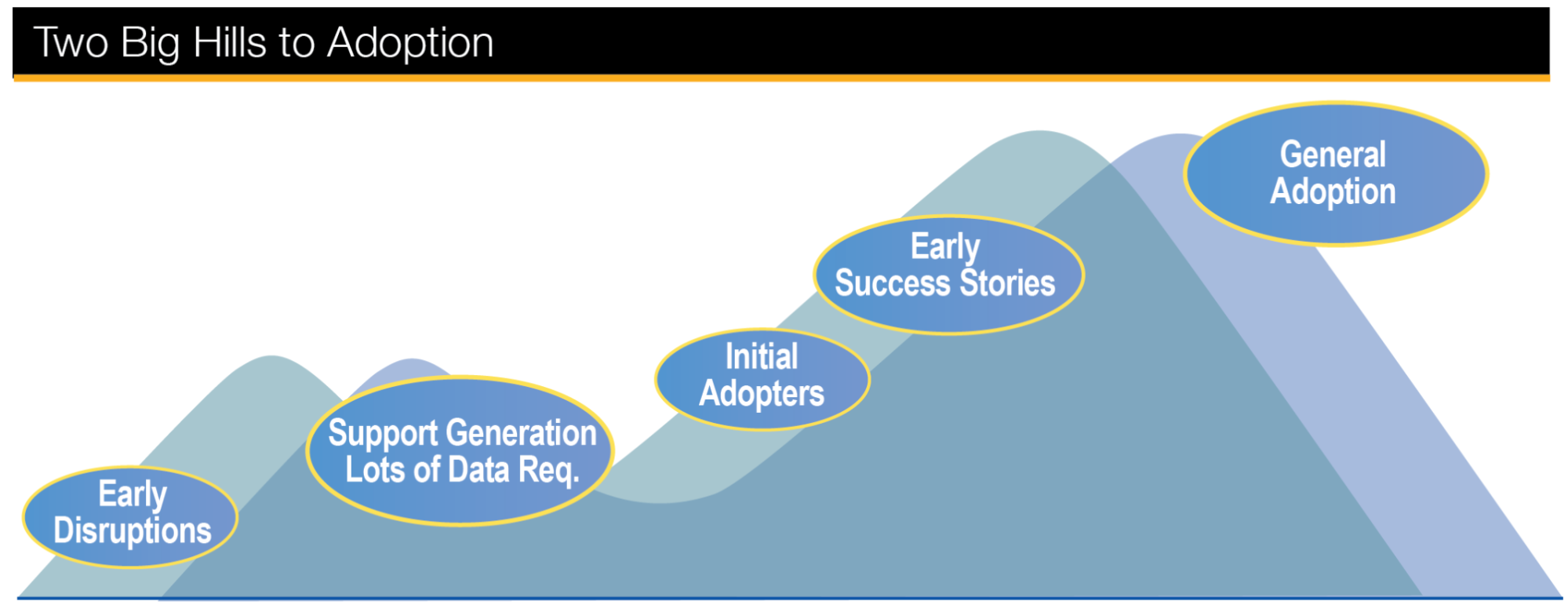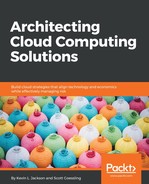The second layer of the design triangle is having a thorough understanding of organizational strategy and goals. The cloud solution design must support and advance the organization's strategy and goals or it will be deemed a failure. To ensure alignment, the solution architect must discuss goals and strategy with the business owner and agree on the key metrics and target values. Some of the most popular cloud computing goals are as follows:
- Agility: Cloud computing delivers improved agility because it has on-demand self-service and rapid elasticity. These attributes enable enterprises to quickly innovate, introduce new products and services, enter new markets, and adapt to changing circumstances. Business agility also requires the ability to create new business processes and change existing ones. Cloud computing can eliminate procurement delays often associated with development and testing by enabling development resources to be available on-demand. Resource scaling enables service levels to be maintained and reduces cost. Cloud-based strategies can also help an enterprise acquire capabilities without the need for training.
- Productivity: The cloud can provide a more productive environment for collaborative working. The use of cloud-based tools for email, instant messaging, voice communication, information sharing and development, event scheduling, and conferencing are well known. The cloud can also provide shared logic in a business ecosystem.
- Quality: The cloud can deliver better quality-IT because usage information gives the enterprise an understanding of how IT is operating. Better understanding enables effective planning, equitable resource sharing, and increased resource efficiency. The ability to use web portals to automatically provision and configure resources gives the cloud service consumers substantially better management capabilities versus non-cloud system. Economies of scale also make the cost and effort required to of duplicate systems for disaster recovery relatively small. Server consolidation, resource optimization, increased asset utilization, and thin client use enhances cloud computing efficiency and reduces the carbon footprint.
- Reduced cost: Cloud computing reduces IT costs by delivering effective resource optimization, by being able to move processor, memory, storage, and network capacity among users almost instantly. Significant cost reductions can be obtained by replacing expensive client devices with cheaper client devices that provide just a user interface to the application server. Community clouds provide an easier path for a community of enterprises to share the cost of common resources. If the organizational goal is maximizing financial capital use through the improved use of the debt and equity funds, the OPEX opportunity provided by cloud computing will directly support that strategy.
- Identification of new business opportunities through morphing a company into becoming a cloud service provider. A company that excels in the quality of its IT may easily become a public IaaS or PaaS provider. Implementing services in the cloud would make them accessible to a large, global market.
- Operational risk/reward balance can be improved by moving low-risk activities to an on-demand service environment. Other on-demand business opportunities may be unveiled exist by mitigated risk management through partnerships and risk sharing. High risk can be reduced by sharing selected business process operations that are strongly correlated to operational or legal failures. This may include corporate risks linked to identifiable software applications, infrastructure components, or specified services. Corporate benefits should be traded-off against these corporate risks with consideration of whether business activities with low corporate returns can be commoditized for competitive advantages. This strategic direction could identify opportunities to improve market share, revenue, profit, or cost management through on-demand delivery of cloud services.
- Modifications to the business products line could be both transformative and disruptive. Opportunities to exploit existing markets with current products and services could be profitable as a utility or commodity offering. A company may be able to offer existing services in a self-service model that has been augmented and enhanced with on-demand features. Unique products services sourced and delivered via an on-demand portal could also be disruptive to existing product lines. If this is the case, the cost-benefit exchange here must be analyzed. Rapid scaling and expansion of offered services could deliver additional value.
- Reducing investment in non-differentiating processes through the use of SaaS could significantly improve an organization's bottom line. Areas where this has been particularly helpful include:
- Business management area, which includes skills management, benefits administration, compensation planning, and human capital management (HCM)
- Financial management (FM) in the areas of accounting, financial and compliance reporting, real estate management, Sarbanes-Oxley (SOX), finance taxes, BASEL II, order to cash, business performance management, and risk management
- Customer relationship management (CRM) that supports sales, business intelligence (BI), customer experience management (CEM), business analytics, call center management, campaign management, sales force automation (SFA), and sales analytics
- Supply chain management (SCM), especially procurement, supplier relationship management (SRM), inventory management, logistics, and import compliance processes
- Manufacturing management of product lifecycle (PLM), resource and capacity, and workforce
- Information technology (IT) services associated with IT architecture design, data center operation, and software development
- Corporate headquarters activities such as research and development (R&D), communications, strategy, and portfolio management, legal, and marketing:
- Internal business process scope and complexity can be adjusted by considering what niche business processes could be moved to a CSP. This could range from moving a specific IT operation to an on-demand provider or commoditizing a service for competitive low-cost advantages. Both large organization-wide operations and smaller, localized activities should be considered. Management should also make specific decisions on which specific business processes need to stay under the control of the business for competitive advantage or whether complex processes can be improved by reducing the number or complexity of the steps involved.
- Cloud computing has a history of improving collaboration/information sharing through the use of on-demand personal productivity tools. This area can also be used to addresses debates around whether personal information and assets created by individuals should be classified as the private intellectual property of the corporation. Collaboration across a community of users can raise similar issues, by raising intellectual property issues regarding creating assets on a shared platform or ecosystem business service environment. When addressing private information, corporate rules that identify and define data ownership and the partitioning of corporate information from that which is private should be part of the strategy process. This will often drive decisions regarding the suitability of secure storage and access control service.
-
In the case of public information, corporate and personal data rules should prohibit the storage of, and access to, personal and corporate information from public locations. Local and national legislation affects this as well. Information held publicly must be monitored and managed at a level that meets legal e-discovery standards. Personal and corporate information must be classified, partitioned, and effectively isolated for storage and use in public locations. The various components of the business process are shown in the following diagram:

An architect's success in overcoming the two big hills to adoption of cloud computing services will be influenced mostly by a solution's alignment with relevant business drivers and strategies. The solution must also pay homage to the intended customer value proposition.

The most broadly recognized cloud computing business drivers are:
- Cost flexibility, which shifts fixed cost to variable cost and allows the implementation of the pay-as-and-when-needed model
- Business scalability that provides flexible, cost-effective computing capacity
- Market adaptability, which enables faster time to market and supports business or mission experimentation
- Masked complexity that helps expand product and service sophistication while simultaneously allowing for greater end-user simplicity
- Context-driven variability that is used to better define the user experience which, in turn, increases product relevancy
- Ecosystem connectivity, which fosters new commerce value nets, which can drive and create new business models
Business strategies most often supported by these business drivers are:
- Product and service optimization that enhance the customer value proposition improve current industry value chains and uses the cloud to incrementally enhance their customer value propositions while improving their organization's efficiency.
- Marketplace innovation that aims at extending the customer value proposition through the transformation of industry value chain and improving customer value. This strategy choice often results in brand-new revenue streams and ecosystem role modifications.
- Market disruption is focused on inventing new customer value propositions and creating new industry value chains by generating new customer needs and segments.
Value chain enhancement is accomplished by building new industry value chains or disintermediate existing ones. Cloud adoption can also aid an organization that is struggling to maintain its place within an existing value chain. This is accomplished through increased efficiency and improved capability to partner and collaborate. Transformative organizational goals can be attained through the development of new operational capabilities, changing the organization's existing industry role or by deciding to enter a completely different marketplace or industry.
If organizational goals revolve around improving the customer value proposition, companies can garner incremental revenue through improvements in current products and services and enhancement of customers' experiences. Cloud computing services can help a company explore or create new distribution channels or payment methods. This could attract existing or adjacent customer segments. This vector could also lead to the creation of a new marketplace need which would attract new customer segments and generate unique revenue opportunities.
The various economic options cloud enables often drives innovative business models. This is accomplished by having a model that ensures a dollar of revenue for every dollar of expense. Cloud computing economic payment options include:
- On demand, in which you only incur cost for the service your organization actually consumes
- Reserve, where a company is obligated to pay for a predetermined quantity of service provider resources at a discounted price
- Spot market, which is an open marketplace auction model that varies resource cost by varying demand for that resource
